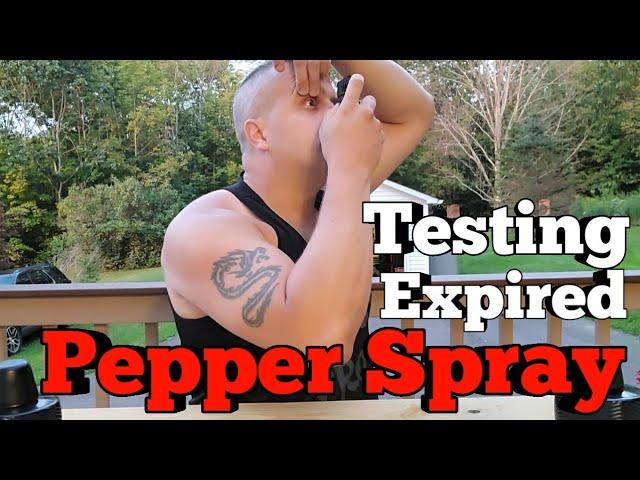Table of Contents
- Understanding the Composition and Stability of Pepper Spray
- Factors Influencing the Shelf-Life of Pepper Spray
- How to Read and Interpret Expiration Dates on Pepper Spray Canisters
- Best Practices for Storing Pepper Spray to Maximize Effectiveness
- Wrapping Up
Understanding the Composition and Stability of Pepper Spray
Pepper spray primarily consists of oleoresin capsicum (OC), an oily extract derived from hot chili peppers, suspended in a liquid carrier such as water or alcohol. This active component is responsible for the intense burning sensation that incapacitates an attacker. To enhance effectiveness and ensure smooth expulsion, manufacturers often add propellants and stabilizing agents. However, the natural oils and compounds in the mixture are prone to chemical changes over time. Exposure to heat, light, and air can cause the OC to degrade, reducing the spray’s potency and altering the aerosol’s performance.
Several factors influence the stability of pepper spray formulations, including:
- Storage conditions: High temperatures and direct sunlight accelerate degradation.
- Container integrity: Leaks or compromised seals may lead to evaporation or contamination.
- Formulation additives: Some sprays include antioxidants or preservatives to extend shelf life.
Factors Influencing the Shelf-Life of Pepper Spray
Several crucial elements determine how long pepper spray remains effective after manufacture. Storage conditions play a pivotal role; exposure to extreme temperatures, sunlight, or humidity can degrade the active ingredients, diminishing the spray’s potency over time. Keeping the canister in a cool, dry place away from direct light helps preserve the chemical formulation. Additionally, the quality of the propellant and seal integrity influence shelf-life, as compromised containers may leak or allow air intrusion, causing oxidation that reduces the spray’s reliability during an emergency.
Moreover, the composition and concentration of the active chemical agents directly affect how long the pepper spray lasts. Most commercial sprays contain capsaicinoids derived from chili peppers, and their stability varies based on formulation. The canister design and manufacturing standards also matter-high-quality products often adhere to stricter guidelines, ensuring a longer, more predictable expiration period. To maintain safety and effectiveness, always review expiration dates printed on the label and replace any product that shows signs of deterioration or reaches its limit.
- Temperature Sensitivity: Avoid heat and freezing temperatures
- Light Exposure: Store away from direct sunlight
- Seal Integrity: Prevent leaks and seal breaks
- Chemical Stability: Note formulation specifics
- Manufacturing Quality: Trust reputable brands for longevity
How to Read and Interpret Expiration Dates on Pepper Spray Canisters
When examining a pepper spray canister for its expiration details, it’s important to first locate the expiration date stamp-usually found on the bottom or side of the can. This date is often formatted as MM/YYYY or MM-DD-YYYY, indicating the last month and year the manufacturer guarantees optimal potency. Keep in mind that some brands may incorporate batch codes or manufacturing dates instead, which require cross-referencing with the brand’s website or customer service for accurate shelf-life information. Understanding these markings ensures you don’t rely on a compromised product during critical moments.
Beyond just the printed date, visually inspect the canister for any signs of damage, rust, or leakage that may affect performance regardless of the expiration date. Key points to remember include:
- Check consistency: A pepper spray that has passed its expiration might emit a less forceful spray or clog easily.
- Storage conditions: Extreme heat or cold can shorten the effective lifespan even before the printed date.
- Regularly test: Conduct a short test spray periodically in a safe environment to ensure function without wasting the entire canister.
Best Practices for Storing Pepper Spray to Maximize Effectiveness
Maximizing the effectiveness of your pepper spray starts with proper storage. Exposure to extreme temperatures, direct sunlight, or moisture can degrade the active ingredients and compromise the canister’s pressurization. For optimal longevity, keep your pepper spray in a cool, dry place away from direct heat sources like radiators or car dashboards. Avoid storing it in areas subject to rapid temperature changes, which can weaken the canister’s seal and reduce spray performance when you need it most.
Additionally, handling and storage practices can prolong the product’s shelf life significantly. Ensure the cap is tightly secured and the spray valve is free from dust and debris. Consider these quick tips for maintaining potency:
- Store the can upright to prevent clogging and leakage
- Keep it out of reach of children and pets but within easy access for emergencies
- Periodically check the expiration date and perform a test spray in a safe environment
- Replace your pepper spray once it reaches its expiration to guarantee peak functionality
Wrapping Up
In sum, being aware of your pepper spray’s shelf-life and expiration dates is crucial for ensuring its effectiveness when you need it most. Regularly checking the expiration date, storing your spray properly, and replacing it as recommended can make all the difference in a critical situation. Staying informed and prepared not only boosts your personal safety but also gives you peace of mind. Remember, a well-maintained pepper spray is a reliable tool in your self-defense arsenal-don’t let it expire unnoticed. Stay safe and stay vigilant!Check Our Other Blogs
- StunGun – Your Trusted Source for Stun Guns, Laws, and Self-Defense Tips
- PepperSprayLaws – Your Trusted Resource for Pepper Spray Information
- StunGunLaws – Your Trusted Guide to Stun Gun Legality and Safety




